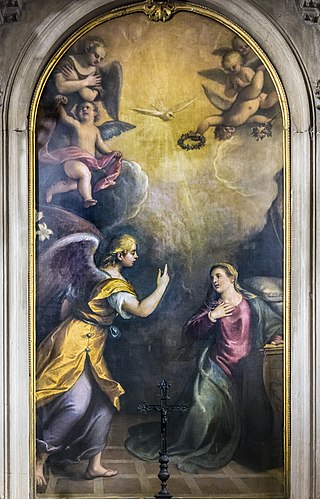
Tiziano Vecelli or Vecellio, Latinized as Titianus, hence known in English as Titian, was an Italian Renaissance painter, the most important artist of Renaissance Venetian painting. He was born in Pieve di Cadore, near Belluno. During his lifetime he was often called da Cadore, 'from Cadore', taken from his native region.

Antonio d'Enrico, called Tanzio da Varallo, or simply il Tanzio was an Italian painter of the late-Mannerist or early Baroque period.

Francesco Vecellio was a Venetian painter of the Italian Renaissance. He was the elder brother and close collaborator of the painter Tiziano Vecellio ("Titian").

San Maurizio al Monastero Maggiore is a church in Milan, Northern Italy. It was originally attached to the most important female convent of the Benedictines in the city, Monastero Maggiore, which is now in use as the Civic Archaeological Museum. The church today is used every Sunday from October to June to celebrate in the Byzantine Rite, in Greek according to the Italo-Albanian tradition. It is also used as a concert hall.

Antonio Randa was an Italian painter of the classicist period, active in Ferrara, Modena, Rovigo, Florence, Comacchio and his native Bologna.

Marco Vecellio (1545–1611) was an Italian painter of the Renaissance period. He was also called Marco di Tiziano, since he was Titian's nephew. He was born and active mainly in Venice. He accompanied his distinguished uncle in the journeys to Rome and Germany. He was the favorite pupil of Titian, and approached nearer to his style than any other member of the family. There are several pictures by him in the Doge's palace, among the best an allegory in the ante-chamber to the Sala del Gran Consiglio. Another good example is a picture in the Sala della Bussola, Doge Leonardo Donato before the Virgin and Infant Christ. He also painted for churches at Venice, Treviso, and in the Friuli, among other things a Christ fulminating the world, and The Virgin on Earth Sending the Two Founders Dominic and Francis for the church of San Zaniopolo at Venice.

The Eleven Caesars was a series of eleven painted half-length portraits of Roman emperors made by Titian in 1536-1540 for Federico II, Duke of Mantua. They were among his best-known works, inspired by the Lives of the Caesars by Suetonius. Titian's paintings were originally housed in a new room inside the Palazzo Ducale di Mantova. Bernardino Campi added a twelfth portrait in 1562.

La Schiavona, also known as Portrait of a Lady, is a 1510–1512 portrait by Titian of an unknown woman.

The Serravalle Altarpiece or Madonna and Child in Glory with Saint Andrew and Saint Peter is a painting by Titian, now in the church of Santa Maria Nova in Serravalle, for which it was commissioned.

The Castello Roganzuolo Altarpiece, Castello Roganzuolo Polyptych or Madonna and Child with Saint Peter and Saint Paul is a painting by Titian, commissioned in 1543 by the leading citizens of Castello Roganzuolo, Province of Treviso, Veneto, Italy. It is now in the Albino Luciani Diocesan Museum in Vittorio Veneto.
Col di Manza is a hill between the towns of Colle Umberto and San Fior in the province of Treviso in Italy, facing the higher hill of Castello Roganzuolo. It is notable as the site of a villa built for the painter Titian.

The Scuola del Santo or Scoletta was the headquarters of the Archconfraternity of St Anthony of Padua. It overhangs the churchyard of Basilica of Saint Anthony of Padua, next door to the St. George's Oratory.

The Lochis Madonna is an oil on panel painting attributed to Titian and dated to around 1508–1510. It is now in the Accademia Carrara in Bergamo. It is first recorded as part of the Lochis collection, after which it is named.

The Rovelli Altarpiece is a 1539 oil on canvas painting by Moretto da Brescia, which since 1899 has been in the Pinacoteca Tosio Martinengo in Brescia, Italy. Strongly influenced by Titian, it is named after the schoolmaster Galeazzo Rovelli who commissioned it for the church of Santa Maria dei Miracoli in Brescia in 1539, where it remained until being removed in the 19th century and replaced by a copy. Its composition was reused by Moroni in his Mystic Marriage of Saint Catherine in the 1560s.

Madonna and Child with Saint Jerome and Saint Dorothy is a 1516 oil on canvas painting, now in the Kelvingrove Art Gallery and Museum in Glasgow, which purchased it from the McLellan collection in 1856. The Madonna's pose is based on that of Raphael's Esterhazy Madonna.

Minerva between Geometry and Arithmetic is a 1550 fresco fragment, usually attributed to Paolo Veronese but by some art historians to Anselmo Canera or Giambattista Zelotti. It was painted for the Palazzo de Soranzi in Castelfranco Veneto but now in the Palazzo Balbi in Venice.

The Concert or The Interrupted Concert is a c. 1510–1511 oil on canvas painting by Titian, now in the Galleria Palatina, in Florence. A copy in the Galleria Borghese includes an additional fourth figure.

Madonna and Child with Saint Catherine of Alexandria is a c.1550 oil on panel painting by the studio of Titian, now in the Galleria degli Uffizi. It was restored around the end of the 18th century, when the present carved and gilded frame was probably added.

Portrait of Cardinal Alessandro Farnese is a c. 1545–46 oil on canvas three-quarter-length portrait of Alessandro Farnese the Younger (1520–1589) by Titian, now in the Museo nazionale di Capodimonte in Naples.

The Bergamasque and Brescian Renaissance is one of the main variations of Renaissance art in Italy. The importance of the two cities on the art scene only expanded from the 16th century onward, when foreign and local artists gave rise to an original synthesis of Lombard and Venetian modes, due in part to the two cities' particular geographical position: the last outpost of the Serenissima on the mainland for Bergamo and a disputed territory between Milan and Venice for Brescia.


















